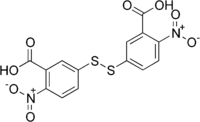- Ellman's reagent
-
Ellman's reagent[1]  5-(3-Carboxy-4-nitrophenyl)disulfanyl-2-nitrobenzoic acidOther namesDithionitrobenzoic acid; 5,5'-Dithiobis(2-nitrobenzoic acid)
5-(3-Carboxy-4-nitrophenyl)disulfanyl-2-nitrobenzoic acidOther namesDithionitrobenzoic acid; 5,5'-Dithiobis(2-nitrobenzoic acid)Identifiers Abbreviations DTNB CAS number 69-78-3 PubChem 6254 ChemSpider 6018 
ChEMBL CHEMBL395814 
Jmol-3D images Image 1 - c1cc(c(cc1SSc2ccc(c(c2)C(=O)O)[N+](=O)[O-])C(=O)O)[N+](=O)[O-]
- InChI=1S/C14H8N2O8S2/c17-13(18)9-5-7(1-3-11(9)15(21)22)25-26-8-2-4-12(16(23)24)10(6-8)14(19)20/h1-6H,(H,17,18)(H,19,20)

Key: KIUMMUBSPKGMOY-UHFFFAOYSA-N
InChI=1/C14H8N2O8S2/c17-13(18)9-5-7(1-3-11(9)15(21)22)25-26-8-2-4-12(16(23)24)10(6-8)14(19)20/h1-6H,(H,17,18)(H,19,20)
Key: KIUMMUBSPKGMOY-UHFFFAOYAD
Properties Molecular formula C14H8N2O8S2 Molar mass 396.35 g mol−1 Melting point 240-245 °C (dec.)
Hazards R-phrases R36/37/38 S-phrases S26 S36  (verify) (what is:
(verify) (what is:  /
/ ?)
?)
Except where noted otherwise, data are given for materials in their standard state (at 25 °C, 100 kPa)Infobox references Ellman's reagent (5,5'-dithiobis-(2-nitrobenzoic acid) or DTNB) is a chemical used to quantify the number or concentration of thiol groups in a sample.[2]
Contents
Preparation
In Ellman's original paper,[2] he prepared this reagent by oxidizing 2-nitro-5-chlorobenzaldehyde to the carboxylic acid, introducing the thiol via sodium sulfide, and coupling the monomer by oxidization with iodine. Today, this reagent is readily available commercially.
Ellman's test
Thiols react with this compound, cleaving the disulfide bond to give 2-nitro-5-thiobenzoate (NTB-), which ionizes to the NTB2- dianion in water at neutral and alkaline pH. This NTB2- ion has a yellow color.
This reaction is rapid and stoichiometric, with the addition of one mole of thiol releasing one mole of NTB. The NTB2- is quantified in a spectrophotometer by measuring the absorbance of visible light at 412 nm, using an extinction coefficient of 14,150 M−1 cm−1 for dilute buffer solutions,[3][4] and a coefficient of 13,700 M−1 cm−1 for high salt concentrations, such as 6 M guanidinium hydrochloride or 8 M urea.[4] Unfortunately the extinction coefficient for dilute solutions was underestimated in the original 1959 publication, as 13,600 M−1 cm−1, and as noted in a recent article, this mistake has persisted in the literature.[5] Commercial DTNB may not be completely pure, so may require recrystallization to obtain completely accurate and reproducible results.[4]
Ellman's reagent can be used for measuring low-molecular mass thiols such as glutathione in both pure solutions and biological samples, such as blood.[6] It can also measure the number of thiol groups on proteins.[5]
References
- ^ 5,5′-Dithiobis(2-nitrobenzoic acid) at Sigma-Aldrich
- ^ a b Ellman GL (1959). "Tissue sulfhydryl groups". Arch. Biochem. Biophys. 82 (1): 70–7. doi:10.1016/0003-9861(59)90090-6. PMID 13650640.
- ^ Collier HB (1973). "Letter: A note on the molar absorptivity of reduced Ellman's reagent, 3-carboxylato-4-nitrothiophenolate". Anal. Biochem. 56 (1): 310–1. doi:10.1016/0003-2697(73)90196-6. PMID 4764694.
- ^ a b c Riddles PW, Blakeley RL, Zerner B (1983). "Reassessment of Ellman's reagent". Meth. Enzymol.. Methods in Enzymology 91: 49–60. doi:10.1016/S0076-6879(83)91010-8. ISBN 9780121819910. PMID 6855597.
- ^ a b Riener CK, Kada G, Gruber HJ (2002). "Quick measurement of protein sulfhydryls with Ellman's reagent and with 4,4'-dithiodipyridine". Anal Bioanal Chem 373 (4–5): 266–76. doi:10.1007/s00216-002-1347-2. PMID 12110978.
- ^ Sedlak J, Lindsay RH (1968). "Estimation of total, protein-bound, and nonprotein sulfhydryl groups in tissue with Ellman's reagent". Anal. Biochem. 25 (1): 192–205. doi:10.1016/0003-2697(68)90092-4. PMID 4973948.
External links
- Quantitation of sulfhydryls DTNB, Ellman’s reagent (uses incorrect absorbance coefficient)
Categories:- Organic disulfides
- Benzoic acids
- Nitrobenzenes
Wikimedia Foundation. 2010.

